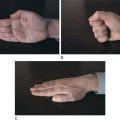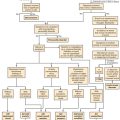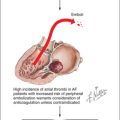CHAPTER 35 Dissociative Disorders
OVERVIEW
Dissociative disorders are among the most controversial, as well as the most intriguing, psychiatric conditions. Central to the conceptualization of dissociation is the understanding that a person’s consciousness may not be fully integrated. Thus, a patient may experience a distinct alteration in personality or experience, in which thoughts, feelings, or actions are not logically integrated with other self-referential experiences.1 Furthermore, although the concept of dissociation is more than 100 years old, there continues to exist great debate as to the validity of the symptoms of dissociation itself, as to whether the symptoms of dissociative disorders are better accounted for as subsets of different psychiatric conditions (e.g., anxiety disorders, posttraumatic stress disorder [PTSD], brief traumatic reactions, psychotic disorders, and attachment disorders), and as to the extent to which political and even cinematic agendas have contributed to the current conceptualization of dissociative syndromes. Certainly, the most famous of the dissociative conditions, dissociative identity disorder (DID), is featured in more than a half a dozen popular films and is sometimes mentioned in the now somewhat discounted “epidemic” of ritual satanic cults said to spawn new cases of dissociative disorder in the 1980s.
Finally, there are a number of dissociative conditions described in the DSM-IV. In addition to DID, these include dissociative amnesia, dissociative fugue, depersonalization disorder, and dissociative disorder not otherwise specified (NOS).2 Additionally, one must remain vigilant against individuals who feign dissociative symptoms for secondary gain or to assume the sick role. These are best characterized as factitious disorders or malingering and are not true dissociative phenomena. This distinction, however, is made difficult by the possibility that many who feign dissociative symptoms might also have true dissociative disorders. Thus, even the differential diagnosis can be contentious.
HISTORICAL PERSPECTIVE
Dissociative phenomena have been observed and described for hundreds of years. In the late eighteenth century, Franz Mesmer explored the concept of dissociation from the perspective of hypnosis, and indeed was likely the first clinician to document the relationship between those who are easily hypnotized and those who are prone to dissociation.3,4 Nearly a century later, Pierre Janet, building on the work of Sigmund Freud, suggested that the ego fragments in the setting of traumatic events, leading to dissociative states. Importantly, this theory represents a departure from Freud’s primary notions regarding trauma and dissociation. While Janet felt that it was primarily a fragile ego that collapsed under the weight of horrifying trauma, thus yielding dissociative symptoms, Freud conceptualized dissociation as the work of a powerful ego defense, in which individuals wall off intense emotional pain as something separate from the self and left to be expressed only in dissociative states.5 Finally, in the early 1900s, Morton Prince wrote “The Dissociation of a Personality,” a lengthy case study that documented his patient, Sally Beauchamp, as “The Saint, the Devil, the Woman.” This was the first in-depth analysis of what is today known as DID.6,7
As mentioned, dissociative disorders became a much discussed subject in psychiatry during the 1980s, in which presumed victims of satanic ritual abuse were often diagnosed with DID and discovered their past via hypnosis and the reclamation of lost memories. Much has been written about the huge recent increase in recovered memories that is often tied to dissociative states, with some clinicians feeling that these cases represent a barely touched-on epidemic of dissociation, whereas others feel strongly that these cases were instead the result of suggestible patients being led to express symptoms and memories that had little basis in the suggested etiology of their predicaments. It is clear that controversy still exists regarding these cases.8
CAUSES OF DISSOCIATION
Virtually all explorations of dissociation involve trauma. The majority of academic writing that discusses dissociation occurs in the trauma literature, and scholars have even defined trauma itself as a threat to one’s personal integrity. This is in fact one of the main reasons some believe that dissociative behavior is more a subset of PTSD, with the symptoms of disconnection representing the flashbacks, reexperiencing, and numbing that are central to the diagnosis of PTSD.9,10
Additionally, those who are more easily hypnotized are also more prone to dissociation. As younger people and especially children are also more easily hypnotized, this finding is perhaps tied to the fact that younger individuals are also more likely to dissociate. Finally, to the extent that deficiencies in early attachment have been tied to dissociation, it may be that children are more prone to dissociation simply because they have more recently experienced the challenges to secure attachment that have been suggested as etiological to dissociation.11,12
From a more biological perspective, dissociative-like states have long been observed in patients who are given dissociative anesthetics (such as midazolam), or who use illicit substances such as lysergic acid diethylamide (LSD).11,13 These findings suggest irregular serotonin activity as playing some role in dissociative phenomena. Additionally, many patients with brain injury, and especially patients with complex partial seizures, have displayed dissociative behavior.14–17 These findings suggest that multiple triggers, both biological and psychological in origin, mingle in the formation of dissociation as a pathological state.
However, community samples also document a relatively high degree of dissociation in the general population. Although the reasons for this finding are not clear, dissociation has more recently been characterized as akin to state-dependent learning, in which certain information is more easily retrieved from some individuals in specific states of self. As with many psychiatric phenomena, dissociation may exist along a spectrum, with some expressions of dissociation more closely tied to normal states and other symptoms more obviously representative of significant pathology.11
THE EPIDEMIOLOGY OF DISSOCIATION
Estimates as to the prevalence of dissociation vary widely. The overall rate of dissociative disorders is thought to be approximately 10%, based primarily on standardized assessments (such as the Dissociative Experience Scale [DES] and the Structured Clinical Interview for Dissociative Disorders [SCID-D]). Importantly, these assessments have face validity only; therefore, caution must be exercised in interpreting data that stem from these investigations. Additionally, the prevalence of dissociative experiences in the general population is estimated by some to be as high as 75%. It is not clear how to interpret these findings when drawing conclusions regarding the epidemiology of dissociation.11
DIFFERENT DISSOCIATIVE DISORDERS
The DSM-IV lists dissociative amnesia (formerly called psychogenic amnesia), dissociative fugue, DID (formerly called multiple personality disorder), depersonalization disorder, and dissociative disorder NOS among the dissociative disorders. Tables 35-1 through 35-5 summarize important findings for each of these syndromes.
Table 35-1 Dissociative Amnesia (DSM-IV Criteria and Exclusions)
Table 35-2 Dissociative Fugue (DSM-IV Criteria and Exclusions)
Table 35-3 Dissociative Identity Disorder (DSM-IV Criteria and Exclusions)
Table 35-4 Depersonalization Disorder (DSM-IV Criteria and Exclusions)
Table 35-5 Dissociative Disorder NOS (DSM-IV Criteria and Exclusions)
Dissociative amnesia has been defined in DSM-IV as “an inability to recall important personal information, usually of a traumatic nature, that is too extensive to be explained by normal forgetfulness.” (Table 35-1 lists the DSM-IV criteria of this condition and exclusions to it.) Dissociative amnesia may be global, involving a total loss of important personal information, or it may be more localized, in which patients cannot recall specific episodes of behavior or traumatic experiences. These experiences may include self-mutilation, criminal or sexual behaviors, traumatic events, or even marital or financial crises.
The incidence in men and women appears to be equal, and large segments of the general population may suffer brief amnestic periods following a significant large-scale disaster.
The differential diagnosis includes organic syndromes (secondary to brain injuries, lesions, or seizures), as well as factitious disorders and malingering, and the treatment for dissociative amnesia is aimed at the restoration of missing memories, sometimes through psychotherapy and free association, but at times using hypnosis or an amytal interview. Generally speaking, patients with dissociative amnesia recover quickly and completely. However, many patients continue to display a propensity toward amnesia in the setting of trauma.18
Dissociative Fugue
Dissociative fugue is probably the rarest of the dissociative disorders and is characterized in the DSM-IV as “the sudden unexpected travel away from one’s place of daily activities, with inability to recall some or all of one’s past.” Often, patients suffering from dissociative fugue will assume entirely new identities during their fugue episode. (Table 35-2 lists the DSM-IV criteria of this condition and exclusions to it.) Like dissociative amnesia, fugue is typically triggered by a traumatic event and thus appears to be more common during wartime or after natural disasters. Patients suffering from dissociative fugue may appear normal, though they often become confused and distressed when asked questions about their personal history.
The treatment for dissociative fugue is similar to that for dissociative amnesia; the patient is helped to recall the events preceding the fugue, typically with psychotherapy but sometimes through hypnosis or an amytal interview. The prognosis varies. When fugue states are of short duration, they tend to spontaneously resolve. Longer-lasting episodes, however, may be intractable.11,19
Dissociative Identity Disorder
Among the dissociative disorders, DID has received the most attention over the last two decades and has endured considerable controversy. The positive aspects of this controversy involve an ongoing debate regarding the interplay of society on psychiatric nosology, as well as a careful reexamination of all dissociative phenomena and their relationship to consciousness and pathology. DID is defined in the DSM-IV as “the presence of two or more distinct identities or personality states (each with its own relatively enduring pattern of perceiving, relating to, and thinking about the environment and the self).” In addition, the DSM specifies that “at least two of these identities” must periodically “take control of the person’s behavior.” Finally, there must be a demonstrated “inability to recall important personal information that is too extensive to be explained by ordinary forgetfulness.” (Table 35-3 lists the DSM-IV criteria of this condition and exclusions to it.)
DID is characterized by high rates of co-morbid depression, and often by affective symptoms that constitute the presenting complaint. In addition, from one-third to one-half of cases of DID experience auditory hallucinations. Some researchers have suggested that these hallucinations are described as “inner voices,” helping to differentiate these symptoms from the external voices heard by those suffering from schizophrenia and other psychotic disorders. Also, in contrast to individuals suffering from schizophrenia, patients with DID are unusually hypnotizable and do not display evidence of a formal thought disorder.
Psychopharmacological treatments (such as antidepressants and anxiolytics) are often useful in treating the common accompanying complaints of depression and anxiety. However, no pharmacological treatment has been found to reduce dissociation, per se. Benzodiazepines reduce anxiety but can also exacerbate dissociation. Although not routinely used for dissociative disorders, neuroleptics are sometimes employed in patients who are grossly disorganized.11,20,21
Depersonalization Disorder
According to the DSM-IV, depersonalization disorder is characterized by “persistent or recurrent episodes…. of detachment or estrangement from one’s self.” Often, patients with symptoms of depersonalization will “feel like an automaton or like he or she is living in a movie.” (Table 35-4 lists the DSM-IV criteria of the condition and exclusions to it.)
Studies have suggested that as many as 50% of people will at some point endorse transient symptoms of depersonalization, and in most cases these symptoms cause little disruption and are not considered pathological. However, frequent depersonalization can be quite disruptive, interfering with daily function and preventing the integration of new experiences. Also, while transient depersonalization is roughly equal among men and women, depersonalization disorder is about twice as common in women as it is in men. Depersonalization disorder usually begins by late adolescence or early adulthood, with most episodes lasting from hours to weeks at a time. Symptoms of depersonalization have also been described in those with severe depression or psychosis, among patients taking illicit substances, and as result of specific brain damage, migraines, or seizures.
Treatment is difficult, and patients are often refractory to interventions. Treatment of accompanying psychiatric conditions (such as depression or anxiety) may help. As with other dissociative disorders, exploration of prior traumatic events may prove useful.11,22,23
Dissociative Disorder Not Otherwise Specified
This category is reserved for presentations in which the predominant feature is dissociation without meeting criteria for any specific dissociative disorder. (Table 35-5 lists the DSM-IV criteria of this condition and exclusions to it.) Examples of dissociative disorder NOS vary widely. These include patients who experience derealization (the quality of perceiving previously familiar objects in the external world as strange and unfamiliar) but not depersonalization, or patients with ill-defined alternate personalities. In addition, symptoms that result from torture or brainwashing may be classified in this category. Ganser’s syndrome (sometimes called “prison psychosis”) is classified as a dissociative disorder NOS. It is characterized by the provision of approximate answers, that is, offering half-correct answers to simple inquiries, such as answering “Five” to the question, “What is two plus two?” The correct set of the response is given, but the answer is inaccurate. Ganser’s syndrome is often reported in incarcerated populations.24–26
FACTITIOUS DISORDERS OR MALINGERING OF DISSOCIATIVE PRESENTATIONS
An additional source of controversy regarding dissociative disorders involves the widely reported imitation of dissociative symptoms among patients seeking secondary gain. These incidences may be more common than previously recognized, with at least one study suggesting that 10% of patients with symptoms of DID were in fact suffering from factitious disorders, with the assumption of the sick role as their primary motivator. Other patients might feign symptoms for financial gain or to avoid financial responsibility. These cases are very difficult to discern, and certainly the treatment will be radically different from the treatment for those who suffer from true dissociative disorders. Some have noted among patients who feign symptoms that there is often great investment in the diagnosis and unusual knowledge of the various dissociative syndromes. However, given the ease of access to information that characterizes modern technology, one must guard against false assumptions regarding the well-informed but legitimately dissociating patient. These matters substantially complicate the recognition and treatment of dissociative disorders.27,28
1 Nehmiah JC. Dissociative disorders. In Kaplan HI, Sadock BJ, editors: Comprehensive textbook of psychiatry, ed 6, Baltimore: Williams & Wilkins, 1995.
2 American Psychiatric Association. Diagnostic and statistical manual of mental disorders, ed 4. Washington, DC: American Psychiatric Association Press, 1994.
3 Spiegel D. Mesmer minus magic: hypnosis and modern medicine. Int J Clin Exp Hypnosis. 2002;50(4):397-406.
4 Bob P. Dissociation and neuroscience: history and new perspectives. Int J Neuroscience. 2003;113(7):903-914.
5 Brown P, Macmillan MB, Meares R, Van der Hart O. Janet and Freud: revealing the roots of dynamic psychiatry. Aust N Z J Psychiatry. 1996;30(4):480-489. discussion 489-491
6 Prince M. The dissociation of a personality. New York: Longmans, Green, 1905.
7 White RW. Who was Morton Prince? J Abnorm Psychol. 1992;101(4):354-356.
8 Mulhern S. Satanism, ritual abuse, and multiple personality disorder: a sociohistorical perspective. Int J Clin Exp Hypnosis. 1994;42(4):265-288.
9 van der Hart O, Nijenhuis E, Steele K, Brown D. Trauma-related dissociation: conceptual clarity lost and found. Aust N Z J Psychiatry. 2004;38(11-12):906-914.
10 Candel I, Merckelbach H. Peritraumatic dissociation as a predictor of post-traumatic stress disorder: a critical review. Compr Psychiatry. 2004;45(1):44-50.
11 Coons PM. The dissociative disorders. Rarely considered and underdiagnosed. Psychiatr Clin North Am. 1998;21(3):637-648.
12 Kirsch I, Lynn SJ. Dissociation theories of hypnosis [see comment]. Psychol Bull. 1998;123(1):100-115.
13 Denson R. Dissociative delirium after treatment with lysergide. Can Med Assoc J. 1967;97(20):1222-1224.
14 Swinkels WA, van Emde Boas W, Kuyk J, et al. Interictal depression, anxiety, personality traits, and psychological dissociation in patients with temporal lobe epilepsy (TLE) and extra-TLE. Epilepsia. 2006;47(12):2092-2103.
15 Mula M, Cavanna A, Collimedaglia L, et al. The role of aura in psychopathology and dissociative experiences in epilepsy. J Neuropsychiatry Clin Neurosci. 2006;18(4):536-542.
16 Berthier ML, Posada A, Puentes C. Dissociative flashbacks after right frontal injury in a Vietnam veteran with combat-related posttraumatic stress disorder. J Neuropsychiatry Clin Neurosci. 2001;13(1):101-105.
17 Grigsby J, Kaye K. Incidence and correlates of depersonalization following head trauma. Brain Inj. 1993;7(6):507-513.
18 Brandt J, Van Gorp WG. Functional (“psychogenic”) amnesia. Semin Neurol. 2006;26(3):331-340.
19 Coons PM. Psychogenic or dissociative fugue: a clinical investigation of five cases. Psychol Rep. 1999;84(3 pt 1):881-886.
20 Brand BL, Armstrong JG, Loewenstein RJ. Psychological assessment of patients with dissociative identity disorder. Psychiatr Clin North Am. 2006;29(1):145-168.
21 Kluft RP. Dealing with alters: a pragmatic clinical perspective. Psychiatr Clin North Am. 2006;29(1):281-304.
22 Bunning S, Blanke O. The out-of-body experience: precipitating factors and neural correlates. Prog Brain Res. 2005;150:331-350.
23 Hunter EC, Sierra M, David AS. The epidemiology of depersonalisation and derealisation. A systematic review. Soc Psychiatry Psychiatr Epidemiol. 2004;39(1):9-18.
24 Miller P, Bramble D, Buxton N. Case study: Ganser syndrome in children and adolescents. J Am Acad Child Adolesc Psychiatry. 1997;36(1):112-115.
25 Dalfen AK, Anthony F. Head injury, dissociation and the Ganser syndrome. Brain Inj. 2000;14(12):1101-1105.
26 Feinstein A, Hattersley A. Ganser symptoms, dissociation, and dysprosody. J Nerv Ment Dis. 1988;176(11):692-693.
27 LoPiccolo CJ, Goodkin K, Baldewicz TT. Current issues in the diagnosis and management of malingering. Ann Med. 1999;31(3):166-174.
28 Feldman MD, Ford CV, Stone T. Deceiving others/deceiving oneself: four cases of factitious rape. Southern Med J. 1994;87(7):736-738.







